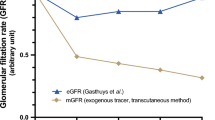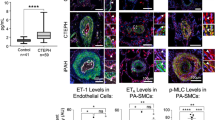Abstract
The pulmonary vasculature of newborns with persistent pulmonary hypertension is characterized by active vasoconstriction and vascular remodeling. It has been suggested that endothelin-1 (ET-1), a potent vasoconstrictor and growth promoter, may be involved in the pathogenesis of persistent pulmonary hypertension of the newborn. To determine whether treatment with an ETA receptor antagonist can reverse pulmonary hypertension in the neonate, 1-d-old piglets were exposed to hypoxia for 3 d to induce pulmonary hypertension and then treated for the remainder of the 14 d with an orally active, nonpeptidic ETA antagonist (TBC3711, 22 mg·kg−1·d−1). At the end of the exposure, Hb, pulmonary artery pressure, right ventricle to left ventricle plus septum weight ratio, percentage wall thickness, ET-1 circulating levels, perfusion pressure, and dilator response to the nitric oxide (NO) donor, SIN-1 (3-morpholinosydnonimine-N-ethylcarbamide) in isolated perfused lungs were determined. Exhaled NO and hemodynamic variables were also examined in an intact anesthetized animal preparation that had undergone the same treatment. By 3 d of exposure to hypoxia, piglets had already developed significant pulmonary hypertension as estimated by their pulmonary artery pressure (24.0 ± 1.3 mm Hg versus 14.2 ± 3.4 mm Hg) and percentage wall thickness (26.6 ± 5.9%versus 18.7 ± 2.4% for vessels 0–30 μm). Whereas further exposure to hypoxia for 14 d did not enhance the increase in pulmonary artery pressure and percentage wall thickness, it did augment the right ventricle to left ventricle plus septum weight ratio (0.71 ± 0.09 versus 0.35 ± 0.01). ET-1 circulating levels were increased only when exposure to hypoxia was prolonged to 14 d (5.1 ± 2.4 pg/mL versus 1.0 ± 0.4 pg/mL). Treatment with TBC3711 from d 3 to d 14, once pulmonary hypertensive changes were established and while hypoxic exposure persisted, caused significant reduction in the right ventricle to left ventricle plus septum weight ratio (0.60 ± 0.06), pulmonary artery pressure (20.0 ± 4.8 mm Hg), and percentage wall thickness (18.5 ± 3.3%) and restored the dilator response to the NO donor SIN-1. Prolonged hypoxia markedly reduced exhaled NO concentrations (0.3 ± 0.6 ppb), although treatment of hypoxic animals with TBC3711 restored the concentration of exhaled NO (4.4 ± 2.8 ppb) to the level of normoxic controls (4.9 ± 3.0 ppb). Lastly, treatment with TBC3711 increased ET-1 circulating levels in both the normoxic (5.4 ± 2.8 pg/mL) and hypoxic (13.0 ± 6.3 pg/mL) groups. In conclusion, the specific ETA receptor antagonist, TBC3711, can significantly ameliorate the morphologic changes encountered in hypoxia-induced pulmonary hypertension in the newborn piglet and may improve the dilator response to NO.
Similar content being viewed by others
Log in or create a free account to read this content
Gain free access to this article, as well as selected content from this journal and more on nature.com
or
Abbreviations
- ED:
-
external diameter
- ET-1:
-
endothelin-1
- ETA:
-
endothelin A receptor subtype
- ETB:
-
endothelin B receptor subtype
- Fico2:
-
fraction of inspired carbon dioxide
- Fio2:
-
fraction of inspired oxygen
- IC50:
-
concentration producing 50% inhibition
- ID:
-
internal diameter
- MSA:
-
medial surface area
- NO:
-
nitric oxide
- PAP:
-
pulmonary artery pressure
- ppb:
-
parts per billion
- PPHN:
-
persistent pulmonary hypertension of the newborn
- PVR:
-
pulmonary vascular resistance
- RV/LV+S:
-
right ventricle to left ventricle plus septum weight ratio
- Sao2:
-
arterial oxygen saturation
- SIN-1:
-
3-morpholinosydnonimine-N-ethylcarbamide
- WT:
-
wall thickness
References
Rudolph AM, Auld PA, Golinko RJ, Paul MH 1961 Pulmonary vascular adjustments in the neonatal period. Pediatrics 28: 28–34
Dukarm RC, Steinhorn RH, Morin FC III 1996 The normal pulmonary vascular transition at birth. In: Glick PL, Irish MS, Holm BA (eds) New Insights into the Pathophysiology of Congenital Diaphragmatic Hernia. Clinics in Perinatology; W.B. Saunders, Philadelphia, pp 711–726
Teitel DF, Iwamoto HS, Rudolph AM 1990 Changes in the pulmonary circulation during birth-related events. Pediatr Res 27: 372–378
Murphy JD, Rabinovitch M, Goldstein JD, Reid LM 1981 The structural basis of persistent pulmonary hypertension of the newborn infant. J Pediatr 98: 962–967
The Neonatal Inhaled Nitric Oxide Study Group 1997 Inhaled nitric oxide in full-term and nearly full-term infants with hypoxic respiratory failure. N Engl J Med 336: 597–604
MacCumber MW, Ross CA, Glaser BM, Snyder SH 1989 Endothelin: visualization of mRNAs by in situ hybridization provides evidence for local action. Proc Natl Acad Sci USA 86: 7285–7289
Chatfield BA, McMurtry IF, Hall SL, Abman SH 1991 Hemodynamic effects of endothelin-1 on ovine fetal pulmonary circulation. Am J Physiol 261: R182–R187
Perreault T, De Marte J 1991 Endothelin-1 has a dilator effect on the neonatal pig pulmonary vasculature. J Cardiovasc Pharmacol 18: 43–50
Masaki T, Vane JR, Vanhoutte PM 1994 International union of pharmacology nomenclature of endothelin receptors. Pharmacol Rev 46: 137–142
Fukuroda T, Fujikawa T, Ozaki S, Ishikawa K, Yano M, Nishikibe M 1994 Clearance of circulating endothelin-1 by ETB receptors in rats. Biochem Biophys Res Commun 199: 1461–1465
Ivy DD, Parker TA, Abman SH 2000 Prolonged endothelin B receptor blockade causes pulmonary hypertension in the ovine fetus. Am J Physiol 279: L758–L765
Fukuroda T, Kobayashi M, Ozaki S, Yano M, Miyauchi T, Onizuka M, Sugishita Y, Goto K, Nishikibe M 1994 Endothelin receptor subtypes in human versus rabbit pulmonary arteries. J Appl Physiol 76: 1976–1982
Perreault T, Baribeau J 1995 Characterization of endothelin receptors in newborn piglet lung. Am J Physiol 268: L607–L614
Rosenberg AA, Kennaugh AJ, Koppenhafer SL, Loomis M, Chatfield BA, Abman SH 1993 Elevated immunoreactive endothelin-1 levels in newborn infants with persistent pulmonary hypertension of the newborn. J Pediatr 123: 109–114
Gosselin R, Gutkowska J, Baribeau J, Perreault T 1997 Endothelin receptor changes in hypoxia-induced pulmonary hypertension in the newborn piglet. Am J Physiol 273: L72–L79
Ivy DD, Ziegler JW, Dubus MF, Fox JJ, Kinsella JP, Abman SH 1996 Chronic intrauterine pulmonary hypertension alters endothelin receptor activity in the ovine fetal lung. Pediatr Res 39: 435–442
Ivy DD, Le Cras TD, Horan MP, Abman SH 1998 Increased lung preproET-1 and decreased ETB-receptor gene expression in fetal pulmonary hypertension. Am J Physiol 274: L535–L541
Berkenbosch JW, Baribeau J, Perreault T 2000 Decreased synthesis and vasodilation to nitric oxide in piglets with hypoxia-induced pulmonary hypertension. Am J Physiol 278: L276–L283
Perreault T, Baribeau J, Gosselin R, Gutkowska J 1997 Reduced vasodilator response to ANF in hypoxia-induced pulmonary hypertension in the newborn piglet. Am J Physiol 273: L289–L295
Wu C, Decker ER, Blok N, Bui H, Knowles V, Bourgoyne A, Holland GW, Brock TA, Dixon RAF 2000 Discovery of potent, orally available, ETA selective endothelin antagonists: TBC3214 and TBC3711. Book of Abstracts 219th American Chemical Society National Meeting: San Francisco, CA, March 26–30, Abstract no. 233
Stavros FD, Hassel KW, Okun I, Baldwin J, Freriks K 1993 COS-7 cells stably transfected to express the human ETB receptor provide a useful screen for endothelin receptor antagonists. J Cardiovasc Pharmacol 22(suppl): S34–S37
Di Carlo VS, Chen S-J, Meng QC, Durand J, Yano M, Chen Y-F, Oparil S 1995 ETA-receptor antagonist prevents and reverses chronic hypoxia-induced pulmonary hypertension in rat. Am J Physiol 269: L690–L697
Colpaert C, Hogan J, Stark AR, Genest DR, Roberts D, Reid L, Kozakewich H 1995 Increased muscularization of small pulmonary arteries in preterm infants of diabetic mothers: a morphometric study in noninflated, noninjected, routinely fixed lungs. Pediatr Pathol Lab Med 15: 689–705
Moon PF, Scarlett JM, Ludders JW, Conway TA, Lamb SV 1995 Effect of fentanyl on the minimum alveolar concentration of isoflurane in swine. Anesthesiology 83: 535–542
Chen S-J, Chen Y-J, Meng QC, Durand J, Di Carlo VS, Oparil S 1995 Endothelin-receptor antagonist bosentan prevents and reverses hypoxic pulmonary hypertension in rats. J Appl Physiol 79: 2122–2131
Tilton RG, Munsch CL, Sherwood SJ, Chen S-J, Chen Y-F, Wu C, Block N, Dixon RAF, Brock TA 2000 Attenuation of pulmonary vascular hypertension and cardiac hypertrophy with sitaxentan sodium, an orally active ETA receptor antagonist. Pulm Pharmacol Ther 13: 87–97
Ivy DD, Parker TA, Ziegler JW, Galan HL, Kinsella JP, Tuder RM, Abman SH 1997 Prolonged endothelin A receptor blockade attenuates chronic pulmonary hypertension in the ovine fetus. J Clin Invest 99: 1179–1186
Albert CJ, Ford DA 1999 Protein kinase C translocation and PKC-dependent protein phosphorylation during myocardial ischemia. Am J Physiol 276: H642–H650
Widimsky J, Urbanova D, Ressel J, Qstadal B, Pelouch V, Prochazka J 1973 Effect of intermittent altitude hypoxia on the myocardium and lesser circulation in the rat. Cardiovasc Res 7: 798–808
Abraham AS, Key JM, Cole RB, Pincock AC 1971 Haemodynamic and pathological study of the effect of chronic hypoxia and subsequent recovery of the heart and pulmonary vasculature of the rat. Cardiovasc Res 5: 95–102
Rabinovitch M, Gamble W, Nadas AS, Miettinen OS, Reid L 1979 Rat pulmonary circulation after chronic hypoxia: hemodynamic and structural features. Am J Physiol 236: H818–H827
Stenmark KR, Mecham RP 1997 Cellular and molecular mechanisms of pulmonary vascular remodeling. Annu Rev Physiol 59: 89–144
Fike CD, Kaplowitz MR 1996 Chronic hypoxia alters nitric oxide-dependent pulmonary vascular responses in lungs of newborn pigs. J Appl Physiol 81: 2078–2087
Mortola JP, Gautier H 1995 Interaction between metabolism and ventilation: effects of respiratory gases and temperature. In: Dempsey JA, Pack AI (eds) Regulation of Breathing, 2nd Ed. Marcel Dekker, New York, pp 1011–1064
Ratcliffe PJ, Jones RW, Philipps RE, Nicholls LG, Bell JI 1990 Oxygen-dependent modulation of erythropoietin mRNA levels. J Exp Med 172: 657–660
Ritthaler T, Gopfert T, Firth JD, Ratcliffe PJ, Kramer BK, Kurtz A 1996 Influence of hypoxia on hepatic and renal endothelin gene expression. Pflugers Arch 431: 587–593
Ihara M, Noguchi K, Saeki T, Fukuroda T, Tsuchida S, Kimura S, Fukami T, Ishikawa K, Nishikibe M, Yano M 1992 Biological profiles of highly potent novel endothelin antagonists selective for the ETA receptor. Life Sci 50: 247–255
Prié S, Stewart DJ, Dupuis J 1998 EndothelinA receptor blockade improves nitric oxide-mediated vasodilation in monocrotaline-induced pulmonary hypertension. Circulation 97: 2169–2174
Prié S, Leung TK, Cernacek P, Ryan JW, Dupuis J 1997 The orally active ETA receptor antagonist (+)-(S)-2-(4,6-dimethoxy-pyridin-2-yloxy)-3-methoxy-3,3-diphenyl-propionic acid (LU 135252) prevents the development of pulmonary hypertension and endothelial metabolic dysfunction in monocrotaline-treated rats. J Pharmacol Exp Ther 282: 1312–1318
Kobzik L, Bredt DS, Lowenstein CJ, Drazen J, Gaston B, Sugarbaker D, Stamler JS 1993 Nitric oxide synthase in human and rat lung; immunocytochemical and histochemical localization. Am J Respir Cell Biol 9: 371–377
Assender JW, Irenius E, Fredholm BB 1996 Endothelin-1 causes a prolonged protein kinase C activation and acts as a co-mitogen in vascular smooth muscle cells. Acta Physiol Scand 157: 451–460
Ohno S 1997 The distinct biological potential of PKC isotypes. In: Parker P, Dekker LV (eds) Protein Kinase C. Springer, London, pp 75–95
Author information
Authors and Affiliations
Corresponding author
Additional information
Supported by the Medical Research Council (MT-12973) and La Fondation du Québec des maladies du coeur.
Rights and permissions
About this article
Cite this article
Perreault, T., Berkenbosch, J., Barrington, K. et al. TBC3711, an ETA Receptor Antagonist, Reduces Neonatal Hypoxia-Induced Pulmonary Hypertension in Piglets. Pediatr Res 50, 374–383 (2001). https://doi.org/10.1203/00006450-200109000-00013
Received:
Accepted:
Issue date:
DOI: https://doi.org/10.1203/00006450-200109000-00013
This article is cited by
-
Therapeutic efficacy of TBC3711 in monocrotaline-induced pulmonary hypertension
Respiratory Research (2011)
-
Intravenous tezosentan improves gas exchange and hemodynamics in acute lung injury secondary to meconium aspiration
Intensive Care Medicine (2008)



